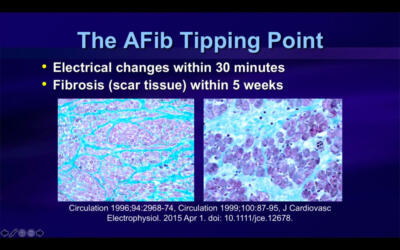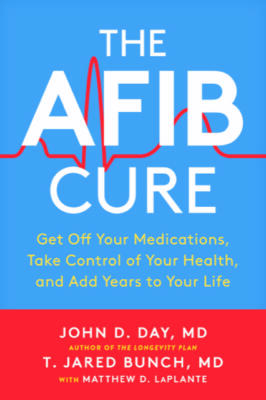#313 Get Out of AFib as soon as Possible
 Dr. John Day
Dr. John DayDr. Day is a cardiologist specializing in heart rhythm abnormalities at St. Mark’s Hospital in Salt Lake City, Utah. He graduated from Johns Hopkins Medical School and completed his residency and fellowships in cardiology and cardiac electrophysiology at Stanford University. He is the former president of the Heart Rhythm Society and the Utah chapter of the American College of Cardiology. |

Podcast: Play in new window | Download
Subscribe: RSS
Get Out of AFib as soon as Possible
A recent study reported that your risk of cardiac death, stroke, or hospitalization could be decreased by 22% if you can get out of AFib as soon as possible. If you’re feeling okay, is there really a rush to get your heart back in rhythm? In this article we discuss the research behind the title of this article–get out of AFib as soon as possible.
EAST-AF Study
The EAST-AF Study was the recent study reporting 22% fewer cardiac deaths, strokes, or hospitalizations with an early rhythm control strategy for AFib. This study was a well-designed randomized controlled multi-center study published in the most prestigious medical journal in the world.
Indeed, of the 2,791 patients followed for over 5 years, the EAST-AF researchers found that all of the bad things mentioned above (cardiac death, stroke, or hospitalization) could be significantly reduced if patients could get out of Afib within 12 months. I could only imagine how much more successful the results of this study would have been if they had gotten their patients back in rhythm within a day, like we do in our practice, rather than wait up to a year!
“Get Out of AFib” also Benefits Heart Failure Patients
In a follow-up to the EAST-AF Study discussed above, a new sub-study just looking at heart failure patients with AFib was published. As AFib patients with heart failure are the highest risk AFib patients, it makes sense to see whether early rhythm control also benefits the sickest of the AFib patients.
As you might expect, the 798 patients with heart failure patients with AFib in this sub-study also benefited significantly from a strategy to get out of AFib. Taken together, these two studies provide a very convincing message that people do best when their hearts are beating in normal sinus rhythm.
How Long Do You Have to Get Out of AFib?
The real question from the EAST-AF main study, as well as the sub-study, is how long do you have to get out of AFib? We certainly know that the longer you are in AFib the harder it is to correct. This is because people that have been out of rhythm too long start to have enlargement of the upper chambers of their heart from too much scar tissue.
Indeed, my co-author on the best-selling book, The AFib Cure, Dr. Jared Bunch, and I wrote an article a few years back discussing the “AFib tipping point.” The AFib tipping point is when you have been out of rhythm so long that normal sinus rhythm is no longer possible. Based on the best research available, electrical degenerative changes to the heart can start to develop within as little as 5 hours of AFib. Even more worrisome is that new scar tissue can develop within 5 weeks of uninterrupted AFib.
This AFib tipping point varies from patient to patient but in general the older you are the faster the tipping point comes. Obviously, if your goal is normal sinus rhythm then the sooner you can get out of AFib the better.
The Longer You Wait for an Ablation the Lower the Success Rate
The AFib tipping point also plays a factor when looking at ablation success rates. Indeed, in our study of 4,535 atrial fibrillation ablation patients, the sooner they could go from AFib diagnosis to ablation the better their long-term freedom from AFib. And this only makes sense as AFib causes degenerative changes to the heart so the sooner you can get out of AFib the better.
But just getting back in rhythm quickly with an AFib ablation is only half the story. The other key finding of our study was that with an early ablation our patients could also cut their death rate in this study by 2.5x as well as cut their hospitalization risk by 1.7x! Once again, when the heart is out of rhythm bad things are more likely to happen.
Dr. Day’s 5 Thoughts on Early Rhythm Control for AFib
1. The sooner you can get back in rhythm the better. As we’ve covered in this article, the longer you are in AFib the greater the chance of degenerative changes to your heart and the higher risk you put yourself in for premature death, strokes, or hospitalizations.
2. If your goal is normal sinus rhythm then why wait? If you know you don’t want to live the rest of your life out of rhythm then it only makes sense to get treatment earlier rather than later.
3. Every patient’s AFib tipping point is different. You really don’t know how long your heart can be in AFib before permanent degenerative changes occur. For some, it could be weeks to months before the AFib becomes permanent while for others it could be many years.
4. Be proactive in getting the care you need. If you are suffering from fatigue, shortness of breath, or “brain fog” from AFib then advocate for normal sinus rhythm. Sadly, I’ve seen many second opinion patients left in AFib for years all because they didn’t complain loudly enough about their AFib symptoms to their original cardiologist.
5. Discuss your AFib case with a cardiac electrophysiologist. Every AFib case is different. And because it is impossible to know what AFib treatment is right for you or when your AFib will no longer be treatable, get in to see a cardiac electrophysiologist or “EP.” EP’s are cardiologists who specialize in arrhythmias like AFib. To find an EP near you, please follow this link.
If you want to learn more and about the importance of getting your AFib treated as soon as possible, be sure to check out our best-selling book, The AFib Cure.
Also, if you liked the photo attached to this article, it is a picture my daughter took of me on one of our regular trail runs overlooking the Salt Lake City valley.

Disclaimer Policy: This website is intended to give general information and does not provide medical advice. This website does not create a doctor-patient relationship between you and Dr. John Day. If you have a medical problem, immediately contact your healthcare provider. Information on this website is not intended to diagnose or treat any condition. Dr. John Day is not responsible for any losses, damages or claims that may result from your medical decisions.


You state: “3. Every patient’s AFib tipping point is different. You really don’t know how long your heart can be in AFib before permanent degenerative changes occur. For some, it could be weeks to months before the AFib becomes permanent while for others it could be many years.” What are the factors behind this? What is the effect of too many ablations? How many is too many ablations? What about wellness care – before, after ablation? If one is in mid-50’s and symptoms are minimal – when is the risk of an ablation not yet worth it?
I read your book thoroughly but at the end I did not find anything about persistent Afib. I have had for 4 years Afib continously for 5 years with no incidents at all. I began to feel fatigue because of the anticoagulants and the bisoprolol that the doctor said I had to take as a prevention measure. NO hope in my case? I am 74 years old. My Afib was discovered by accident because I have no syntoms.
Hello fellow a fibbers.
I had been pro-active with my health for years and with my afib for the past couple of years. As I was putting 2 and 2 together, I cam upon Dr. Day’s bookThe Afib Cure and it pulled it all together for me. Even hearing that thousand of patients had reversed their afib helped give me the confidence that I could also put mine in remission! And so I have…with in days of reading the book and keeping track of everything, i could tell if I was heading for an incident or away from them. It was so exciting and now I have been 4 months afib free and see no turning back..dig in, go for it, believe it and receive it!!